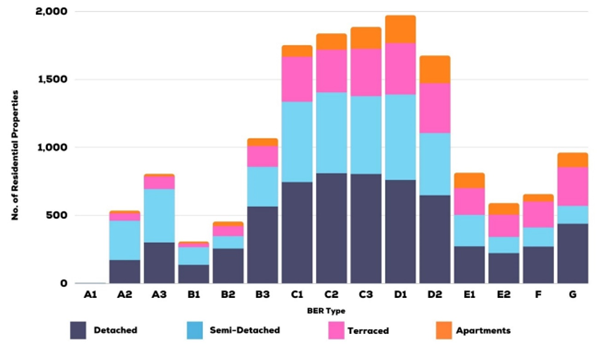Household/Residential Greenhouse Gas Emissions
What is the challenge?
Relative to 2018, Ireland needs to reduce its emissions from electricity consumption by 62-81% and in relation to buildings by 44-56%. The generation of renewable energy such as offshore wind and solar will significantly contribute to these reduction targets.
Questions to bear in mind as you read this page -
- What should the Council do to help reduce emissions from residential energy use?
- What would you like to do to reduce greenhouse gas emissions from energy use in your life?
Where does the Council have influence?
The Council are removing fossil fuel systems from council buildings and carrying out energy efficiency improvements to realise an energy saving of 50% by 2030.
The Council has influence through the Community Climate Action programme. This will see recognised community groups receive funding to undertake energy upgrades in their community halls, sports ground or local area.
The Council assists local communities through the SEAI's Better Energy Community Schemes to source funding.
The Council, through the SEAI, has access to grant funding to improve the energy efficiency of its own social housing stock.
The Council will engage with utility companies in the planning application stage regarding renewable energy developments and projects.
The Council through planning ensures that all new buildings meet the nationally set energy efficiency standards.
What is the national picture?
The Government has launched its updated National Climate Action Plan in 2023. Within this are key measures for energy.
By 2030, the ambition is that Ireland will have enough renewable energy to power every home and business in the country. Wind and solar farms are expanding and improving to make this a reality.
Ireland's residential housing stock is not energy efficient. To change this, the government intends to retrofit 500,000 houses to Building Energy Rating (BER) B2 or higher by 2030 (almost 25% of the buildings in Ireland). Grants are available to assist households with this.
The Government also intends to support at least 500 Megawatts of local community-based renewable energy projects and increase levels of microgeneration and small-scale generation.
The Government is phasing out the use of coal and peat in electricity production
A new, dynamic Green Electricity Tariff will be developed by 2025 to allow people to use lower cost renewable electricity at times of high wind and solar generation.
What is the local picture?
Residential heating in Waterford comes primarily from fossil fuels such as oil and gas. Energy efficiency improvements and local renewable energy generation will reduce reliance on these fuels.

The Building Energy Rating (BER) of Waterford’s housing stock lies on the lower end of the A-G scale, with most houses sitting in the “C” category for energy efficiency with older houses falling in the D to G bracket. Building Energy Ratings have cost implications a C rated house will spend over 3 times as much on energy each year as an A rated house. Through the provision of home energy upgrade grants via the SEAI, it is anticipated that the energy efficiency of homes in Waterford will improve. The Council will look to work with the SEAI to facilitate provision of information and grant application assistance.

There are benefits to households beyond the energy savings if they improve the energy efficiency of their home. For example, a home that goes from a BER of G to a B2 rating will increase its value by 10%. That means when you carry out energy upgrades to your home, you are increasing the value of your home. [1]
The Council’s own building stock also requires retrofitting to reach a 50% energy reduction by 2030. This is being carried out on an incremental basis. The ambition is to remove all fossil-fuelled boilers from Council buildings by 2025, in favour of heat pumps and other energy efficient alternatives.
The Council’ social housing stock will require energy upgrades moving forward. This will ensure lower emissions, a greater degree of warmth for inhabitants along with cost savings and a lower risk of energy poverty occurring.
What are other places doing?
Tallaght District Heating Scheme – South Dublin County Council in conjunction with Codema, Dublin City’s Energy Agency, has set up the first not for profit District Heat Scheme in Ireland. The scheme takes waste heat from a data centre and uses it to heat buildings in the surrounding areas.
College View, Wexford Town – Wexford County Council in conjunction with the Southeast Energy Agency (formerly 3cea) retrofitted 12 homes in Wexford town to an A Building Energy Rating (BER). Similar work has been taking place across Waterford.
Netherlands, Venlo City Hall – The Venlo City Hall was designed to energy efficient and also to improve air quality.
[1] SEAI